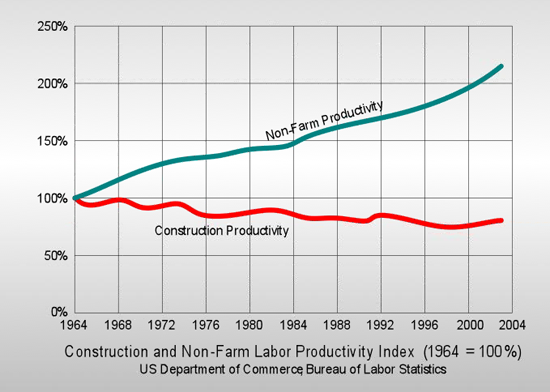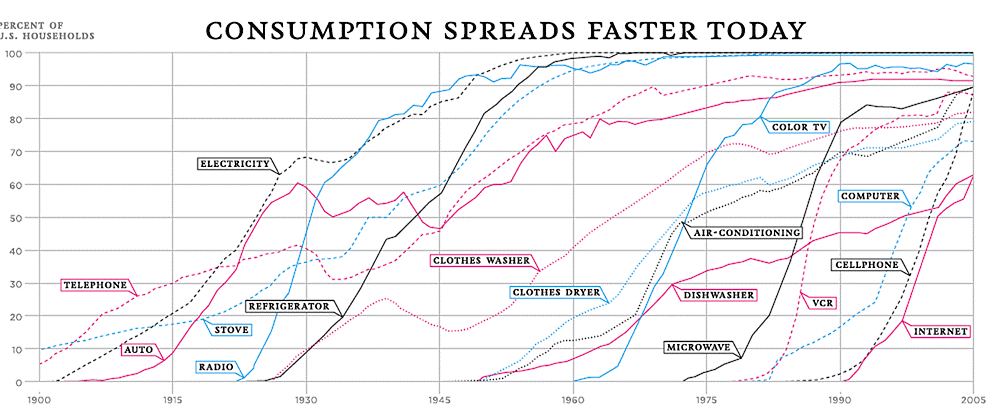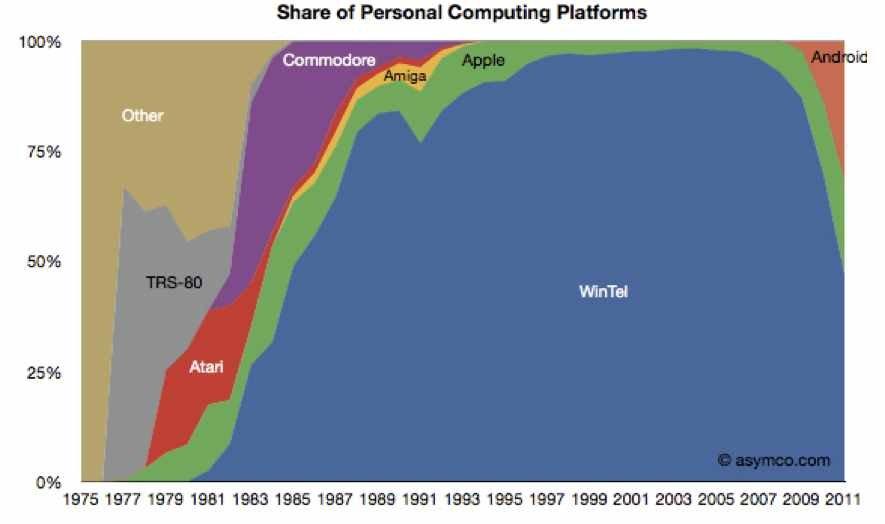|
Over the last 40 years, many industries were enjoying vast improvements in productivity. Much of that productivity was due to the widespread adoption of information technology (IT). Once WinTel computers and connectivity became the norm, information flowed relatively freely between employees and employees, and people could produce, analyze, and communicate data at increasingly faster rates. However, many of these productivity gains from IT were largely missed by the construction industry. There are many reasons why the IT revolution silently passed the construction industry. Two of these reasons are that technology companies, primarily in software development, were reluctant to build software for builders. First, construction companies are cheap, particularly when it comes to new technologies. The rate of R&D spending in the construction industry is paltry at best. I don’t have the exact figure, but it’s maybe 1-2% of revenues. R&D does not equal technology adoption, but suffice it to say, contractors are, by and large, not technology savvy. The second reason, which is related to the first, is that many of the people in the construction industry are luddites. The visual of the crusty superintendent in the field resisting every effort to become more digital is not that far off. So, when you couple a parsimonious industry with people that resist your products, it’s no mystery why all but a few software companies ignored the construction industry. These issues are rapidly dissipating. Many companies, from tried and true construction technology developers (see this robot being built by DPR and Trimble) and some Silicon Valley start-ups (PlanGrid being my favorite), are building new products for the construction industry. At the same time, there’s a huge turnover in talent in the construction industry. As many (technophobic) baby boomers are setting off into retirement, they are being replaced by a new crop of newbies that have grown up with computers and cell phones and are very comfortable with the onslaught of new software and hardware products. This new generation of construction professionals is important. The construction industry, like all industries, will need people that are comfortable with an ever-changing technology landscape. Whereas technologies of past decades took years to be adopted and even longer to be made irrelevant, the lifecycle of technologies coming online today are being rapidly adopted and are made obsolete just as quickly. In the figure below, look how long it took society-altering technologies, such as electricity and radios, to become widely adopted. Now look at computers, cell phones, and the internet. The adoption of new technologies is happening much faster now. What’s more, technology is being developing at an increasingly faster pace with prices for products dropping (see Moore’s Law). It’s almost impossible to fathom what the technology landscape will look like in the construction industry in a decade, but I’m willing to bet green money that it will look dramatically different than it does today. And this doesn’t just apply to “macro” technologies (computers, phones), but also “micro” technologies (operating systems). A decade or so ago, when builders decided to invest heavily in computers, much of the risk was mitigated by the fact that the world was dominated by WinTel machines (computers with Intel processors and the Windows operating system). The biggest decision was HP vs. Dell, which was a decision based primarily on cost (with service as possibly a consideration). Now, there real competition among operating systems, and the market will likely get more fragmented in the near future. So what does this mean for builders? Well, putting it simply, builders need to become savvier. While that sounds incredibly trite, it means that the ENTIRE company must become more savvy. Not just the IT manager and staff, but also senior management, office personnel and field personnel.
Going forward, I will be offering my thoughts and analysis on the subject of technology in the construction industry. But in the near term, I want to mention some key developments that are going to dramatically affect the construction industry: BIM: If you work in the construction industry and haven’t heard of BIM (building information modeling), then you must be living in a cave. BIM is a perfect example of what smart investment in IT can yield. BIM allows contractors and subcontractors/trade partners to perform clash detection before materials are actually installed, saving critical time on site layout and, even better, avoiding rework or late problem discoveries that may lead to project delays. What’s even better about BIM is that it has increasing returns, meaning that the more people that use it, the more valuable it is. That helps increase its return on investment made in BIM for all parties that make the investment. Cloud computing: Almost everyone has heard of the cloud by now, which is good. Even better about the cloud is that it allows project participants to share data easily, irrespective of the device or operating system they’re using (so long as you have an internet connection and a credible web browser, but that should also be a given. If it isn’t for your company, contact me ASAP!). Most of the contractors I communicate with on a regular basis are already leveraging the cloud with high returns. BYOD: BYOD, or bring your own device, means that many of the people participating on a project are bringing their own computing devices (smart phones, tablets, laptops, etc.). Unlike the past, when IT managers only had to worry about building a system around WinTel machines, they must now be prepared to work with wide variety of platforms. Managing a network consisting of phones, laptops, desktops (yes, they still exist) is enough work, but managing those devices with a multitude of operating systems, such as Android, Windows, and iOS further complicates things, particularly when many of these devices are owned by individual employees. And not to cry that the sky is falling, all of this leads to security issues, both between devices and between people. When individual employees walk out the door each night and can take key project information with them on their devices, you had better be thinking about managing data security. The point I want to leave you with is that technology is coming furiously to the construction industry, much faster than it has in the last 5 to 10 years (much faster!). This is a good thing. But companies, from top management on down to the lowest ranks, must be aware of this change and prepare properly in order to see a positive return on investment (or simply to not be run over). There are many more issues to discuss, so I will periodically write about them here. Until then, happy computing.
2 Comments
Leave a Reply. |
Archives
January 2024
Categories |



 RSS Feed
RSS Feed